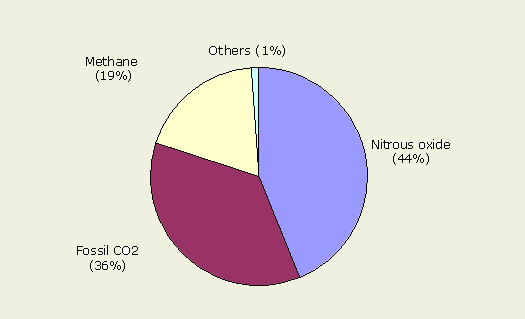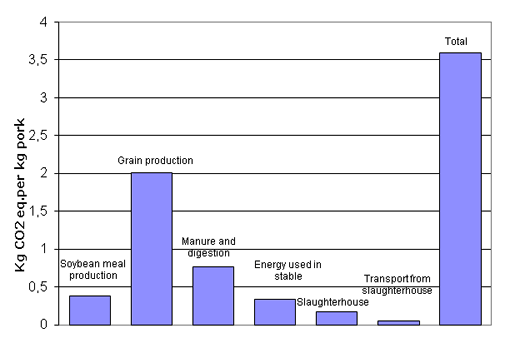LCA of 1 kg Danish Pork
Using an LCA the effect of the production of 1 kg Danish pork on global warming, nutrient enrichment and acidification can be calculated. The results from an LCA are given in Table 5. It can be noticed that the effect on global warming of the production of 1 kg Danish pork correspond to 9 km of car driving.
Table 5. LCA of 1 kg Danish pork (2005)
| Impact category | Unit | 1 kg Danish pork | 9 km car driving |
| Global warming | kg CO2 eq. | 3.6 | 3.6 |
| Nutrient enrichment | g NO3 eq. | 232 | |
| Acidification | g SO2 eq. | 46 |
The contribution on global warming of 1 kg Danish pork is calculated in CO2 equivalents, which means that the sum at 3.6 kg CO2 equivalents include the emission of all the greenhouse gases (GHG) which have been converted to CO2-equivalents using the factors in Table 1. Figure 8 below gives an indication on what types of greenhouse gases are emitted during the production of Danish pork, and the approximately amount of these gases.

Figure 8. The share of different of greenhouse gases emitted during the production of Danish pork
The 3.6 kg CO2 eq. emitted from the production of 1 kg Danish pork is the sum of emissions from different links of the product chain. These links are the production and transportation of soybean meal (usually imported from South America or China) and grain which is the main ingredient in pig feed. In addition the contribution to global warming includes emissions from manure, the energy used in the stable and slaughterhouses. The transportation of pork only contributes with a small part, approximately 1.5 % of the total greenhouse gases emitted from the product chain of pork (Figure 9).

Figure 9. The contribution to carbon footprint from different links of the product
chain during the production of 1 kg Danish pork
It can be noticed from Figure 9 that the main contribution to the global warming potential comes from the production of grain corresponding to 2 kg CO2-eq. The contribution from manure and digestion has the second highest greenhouse gas emission with approximately 0.8 kg CO2-eq.
In relation to the eutrophication potential from pork production the greatest contribution comes from the production of grain with more than 120 g NO3-eq per functional unit (pork), and with nitrate and ammonia emitted during the cultivation of the grain being the major contributors. The second highest contributor is 'manure application field', which contributes with 62 g NO3-eq. per functional unit. A major part of this is N in the manure, which is leached, because it is not assimilated into the crops. The conventional 'pig housing' contributes with 47 g NO3-eq. per functional unit and the only contributing substance is ammonia. This comes from the manure/slurry excreted in the housing and during storage. The other stages in the production stage only have a very little contribution to the eutrophication potential.
In contrast to the above impact categorise 'pig housing' including 'manure handling' is the largest contributor to acidification potential with 24 g SO2-eq. per functional unit, and with ammonia as the only acidifying substance. However, also grain production has a high contribution with approximately 17 g SO2-eq. per functional unit, whereas 'soybean meal' and 'manure application field' accounts for approximately 2 g SO2-eq. per functional unit.